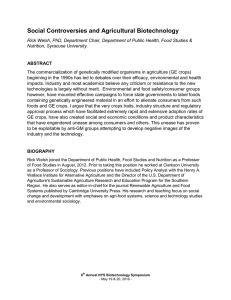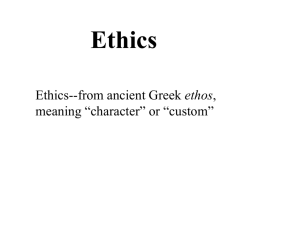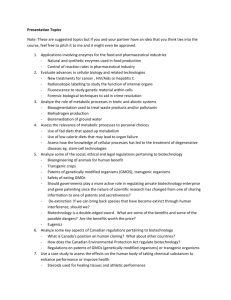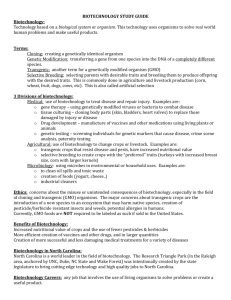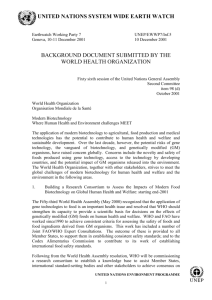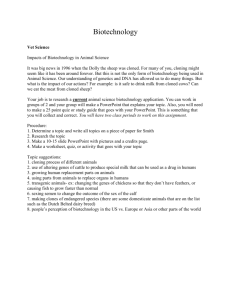Appropriate use of biotechnology offers considerable potential to improve
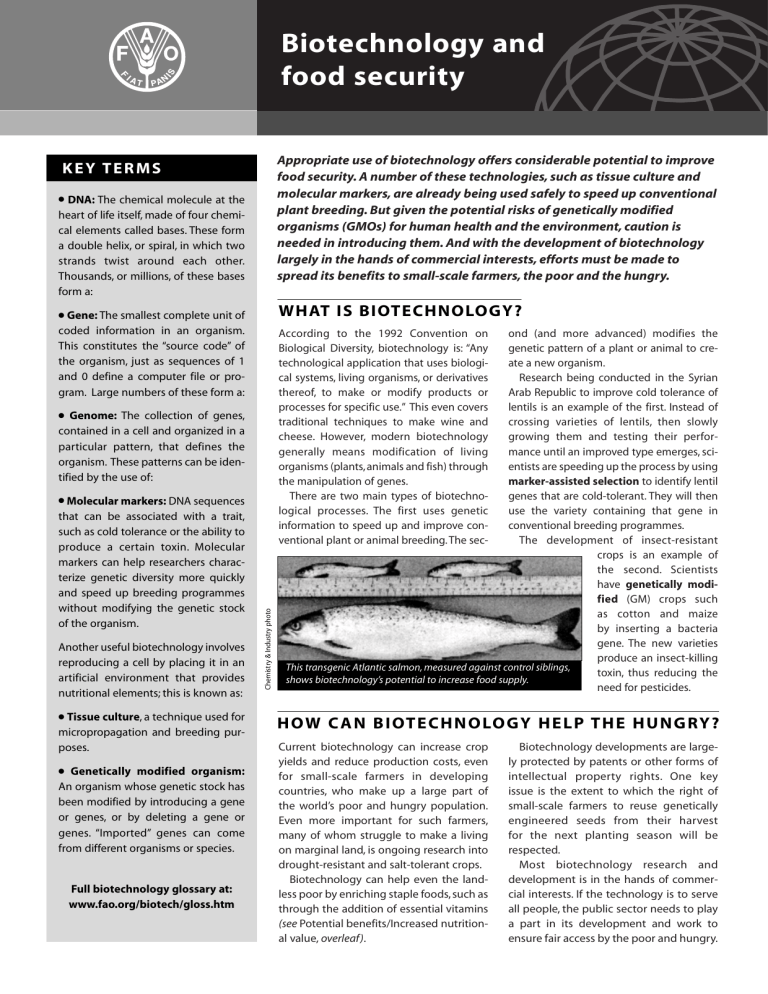
Biotechnology and food security
K E Y T E R M S
● DNA: The chemical molecule at the heart of life itself, made of four chemical elements called bases. These form a double helix, or spiral, in which two strands twist around each other.
Thousands, or millions, of these bases form a:
● Gene: The smallest complete unit of coded information in an organism.
This constitutes the “source code” of the organism, just as sequences of 1 and 0 define a computer file or program. Large numbers of these form a:
● Genome: The collection of genes, contained in a cell and organized in a particular pattern, that defines the organism. These patterns can be identified by the use of:
● Molecular markers: DNA sequences that can be associated with a trait, such as cold tolerance or the ability to produce a certain toxin. Molecular markers can help researchers characterize genetic diversity more quickly and speed up breeding programmes without modifying the genetic stock of the organism.
Another useful biotechnology involves reproducing a cell by placing it in an artificial environment that provides nutritional elements; this is known as:
● Tissue culture , a technique used for micropropagation and breeding purposes.
● Genetically modified organism:
An organism whose genetic stock has been modified by introducing a gene or genes, or by deleting a gene or genes. “Imported” genes can come from different organisms or species.
Full biotechnology glossary at: www.fao.org/biotech/gloss.htm
Appropriate use of biotechnology offers considerable potential to improve food security. A number of these technologies, such as tissue culture and molecular markers, are already being used safely to speed up conventional plant breeding. But given the potential risks of genetically modified organisms (GMOs) for human health and the environment, caution is needed in introducing them. And with the development of biotechnology largely in the hands of commercial interests, efforts must be made to spread its benefits to small-scale farmers, the poor and the hungry.
WHAT IS BIOTECHNOLOGY?
According to the 1992 Convention on
Biological Diversity, biotechnology is: “Any technological application that uses biological systems, living organisms, or derivatives thereof, to make or modify products or processes for specific use.” This even covers traditional techniques to make wine and cheese. However, modern biotechnology generally means modification of living organisms (plants, animals and fish) through the manipulation of genes.
There are two main types of biotechnological processes. The first uses genetic information to speed up and improve conventional plant or animal breeding. The second (and more advanced) modifies the genetic pattern of a plant or animal to create a new organism.
Research being conducted in the Syrian
Arab Republic to improve cold tolerance of lentils is an example of the first. Instead of crossing varieties of lentils, then slowly growing them and testing their performance until an improved type emerges, scientists are speeding up the process by using marker-assisted selection to identify lentil genes that are cold-tolerant. They will then use the variety containing that gene in conventional breeding programmes.
The development of insect-resistant
This transgenic Atlantic salmon, measured against control siblings, shows biotechnology’s potential to increase food supply.
crops is an example of the second. Scientists have genetically modified (GM) crops such as cotton and maize by inserting a bacteria gene. The new varieties produce an insect-killing toxin, thus reducing the need for pesticides.
H O W C A N B I OT E C H N O LO G Y H E L P T H E H U N G RY ?
Current biotechnology can increase crop yields and reduce production costs, even for small-scale farmers in developing countries, who make up a large part of the world’s poor and hungry population.
Even more important for such farmers, many of whom struggle to make a living on marginal land, is ongoing research into drought-resistant and salt-tolerant crops.
Biotechnology can help even the landless poor by enriching staple foods, such as through the addition of essential vitamins
(see Potential benefits/Increased nutritional value, overleaf) .
Biotechnology developments are largely protected by patents or other forms of intellectual property rights. One key issue is the extent to which the right of small-scale farmers to reuse genetically engineered seeds from their harvest for the next planting season will be respected.
Most biotechnology research and development is in the hands of commercial interests. If the technology is to serve all people, the public sector needs to play a part in its development and work to ensure fair access by the poor and hungry.
GM CROPS: WHAT IS BEING GROWN, WHAT IS BEING TESTED
● An estimated 44 million hectares of GM crops were planted in 2000.
● The most common GM crops are soybean (58 percent of GM crop total), maize (23 percent), cotton (12 percent) and canola (7 percent), with smaller amounts of potato, squash and papaya.
● In 2000, Argentina, Canada, China and the United States accounted for 99 percent of the global GM crop area. Other countries growing commercial GM crops were Australia, Bulgaria, France, Germany,
Mexico, Portugal, Romania, South Africa, Spain, Ukraine and Uruguay.
● Many developing countries are involved in GMO research. Field testing of GMOs is under way in:
Million hectares
35
30
25
20
15
USA
Argentina
Canada
China
10
5
0
1995 1996 1997 1998 1999
In 2000, these four countries accounted for 99 percent of the global transgenic crop area, mostly soybean, cotton, maize and canola.
Africa : Egypt, Kenya, South Africa and Zimbabwe are testing one or more of the following: GM wheat, groundnut, cotton, squash, sugar cane and sweet potato.
Asia : China, India, Indonesia, Malaysia, Pakistan, Philippines and
Thailand are testing one or more of the following: GM tobacco, aubergine, tomato, cotton, sorghum and bananas.
2000
Latin America : Argentina, Bolivia, Brazil, Cuba and Mexico are testing 60 GMOs belonging to more than 20 species, including papaya, tobacco, cotton, maize, potato, coffee, sugar cane, sunflower and sugar beet.
GENETIC ALLY ENGINEERED PRODUCTS: MANY UNKNOWNS
Potential benefits
● Increased nutritional value of staple foods: Genes are being inserted into rice to make it produce beta-carotene, which the body converts into vitamin A. This experimental transgenic “golden rice”, has the potential to reduce vitamin A deficiency, a leading cause of blindness and a significant factor in many child deaths.
● Reduced environmental impact: Scientists are developing trees with modified cell lignin content. When used to make pulp and paper, the modified wood requires less processing with harsh chemicals.
● Increased fish yield: Researchers have modified the gene that governs growth hormones in tilapia, a farmed fish, offering the prospect of increased yield and greater availability of fish protein in local diets.
● Increased nutrient absorption by livestock: Animal feed under development will improve animals’ absorption of phosphorus. This reduces the phosphorus in animal waste, which pollutes groundwater.
● Tolerance of poor environmental conditions: Scientists are working to produce transgenic crops that are drought-resistant or salt-tolerant, allowing the crops to be grown on marginal land.
Potential risks
● Inadequate controls: Although safety regimes are being improved, control over
GMO releases is not completely effective. In
2000, for example, a maize variety cleared only for animal consumption was found in food products.
● Transfer of allergens.
Allergens can be transferred inadvertently from an existing to a target organism and new allergens can be created. For example, when a Brazil nut gene was transferred to soybean, tests found that a known allergen had also been transferred. However, the danger was detected in testing and the soybean was not released.
● Unpredictability: GM crops may have unforeseen effects on farming systems – for example, by taking more resources from the soil, or using more water than normal crops.
● Undesired gene movement: Genes brought into a species artificially may cross accidentally to an unintended species. For example, resistance to herbicide could spread from a GM crop into weeds, which could then become herbicide-resistant themselves.
● Environmental hazards: GM fish might alter the composition of natural fish populations if they escape into the wild. For example, fish that have been genetically modified to eat more in order to grow faster might invade new territories and displace native fish populations.
Some GMOs currently available
GMO species
Maize
Soybean
Genetic modification
Source of gene Purpose of genetic modification
Insect resistance Bacillus thuringiensis Reduced insect damage
Herbicide tolerance Streptomyces spp.
Greater weed control
Cotton Insect resistance Bacillus thuringiensis Reduced insect damage
Carnation Alteration of colour Freesia Production of different flower varieties
Rice Pro-Vitamin A Erwinia
Daffodil
Increase Vit A supply
Primary beneficiaries
Farmers
Farmers
Farmers
Retailers and consumers
Consumers
C O N T A C T S For further information , contact:
Plant Production and
Protection Division
Tel. +39 06 570 53751
Fax +39 06 570 56347 nuria.urquia@fao.org
Media inquiries
Tel. +39 06 570 53625
Fax +39 06 570 53729 media-relations@fao.org
Food and Agriculture Organization of the United Nations
Viale delle Terme di Caracalla
00100 Rome, Italy www.fao.org
